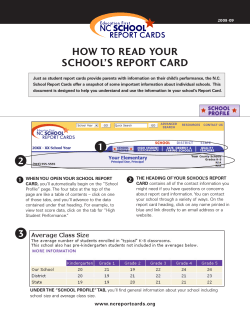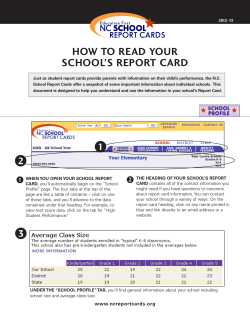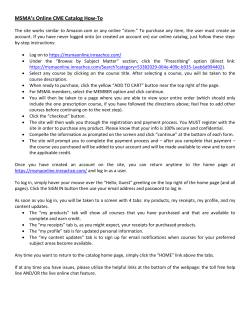
Microsoft Word 2010 Training Create your first Word document I ®
® Microsoft Word 2010 Training Create your first Word document I Course contents • Overview: Start at the beginning • Lesson: Includes seven self-paced sections • Suggested practice tasks • Test • Quick Reference Card Create your first Word document I Overview: Start at the beginning In this course, you’ll learn how to create your first document in Word. You’ll find out how to type where you want to on a page, fix spelling errors, make a list, change page margins, add emphasis to some words, quickly add some style, and save your work. Create your first Word document I Course goals 1. Create and save a new document. 2. Fix spelling and grammar as you type. 3. Add formatting to your text. 4. Change page margins. Create your first Word document I The first time you open Word When you open Word, you see two things, or main parts: 1 The ribbon, which sits above the document, and includes a set of buttons and commands that you use to do things in and with your document (like print it). 2 A blank document, which looks like a white sheet of paper and takes up most of the window. A new, blank document Create your first Word document I Just start typing In the document, look for the cursor, which tells you where the content you type will appear on the page. Word waits for you to start typing. If you’d like to start typing further down the page instead of at the very top, press the ENTER key on your keyboard until the cursor is where you want to type. The cursor – a blinking vertical line in the upper-left corner of the page Create your first Word document I Just start typing When you start typing, the text you type pushes the cursor to the right. If you get to the end of a line, just continue to type. The text and the insertion point will move on to the next line for you. The cursor – a blinking vertical line in the upper-left corner of the page Create your first Word document I Just start typing Once you’ve finished typing your first paragraph, press the ENTER key to go to the next paragraph. If you want more space between the two paragraphs (or any two paragraphs), press ENTER again and then start typing your second paragraph. The cursor – a blinking vertical line in the upper-left corner of the page Create your first Word document I Just start typing If you make a mistake while typing, just press the BACKSPACE key to “erase” the incorrect characters or words. The cursor – a blinking vertical line in the upper-left corner of the page Create your first Word document I Fix spelling and grammar mistakes As you type, Word will warn you if make spelling or grammar mistakes by inserting a wavy red, green, or blue underline beneath the text that it thinks is an error. Red underline: This indicates either a possible spelling error or that Word doesn’t recognize a word, such as a proper name or place. Wavy lines like these warn you of spelling and grammar mistakes. Create your first Word document I Fix spelling and grammar mistakes Green underline: Word thinks that grammar should be revised. Blue underline: A word is spelled correctly but does not seem to be the correct word for the sentence. For example, you type “too,” but the word should be “to.” Wavy lines like these warn you of spelling and grammar mistakes. Create your first Word document I Fix spelling and grammar mistakes You right-click an underlined word to see suggested revisions. Click a revision to replace the word in the document and get rid of the underlines. Wavy lines like these warn you of spelling and grammar mistakes. Create your first Word document I Fix spelling and grammar mistakes A note of caution about green and blue underlines: Word is really good at spelling, which is pretty straightforward most of the time. But grammar and correct word usage take some judgment. If you think that you are right, and Word is wrong, then you can right-click the word and ignore the suggested revisions and get rid of the underlines. Wavy lines like these warn you of spelling and grammar mistakes. Create your first Word document I Format text The press release you’re typing announces the net income and price per share for Contoso Pharmaceuticals. You can call attention to this important information by adding emphasis with bold, italic, or underlined formatting. There are many ways to emphasize text including bold, italic, and underlined formatting. Create your first Word document I Format text Let’s make the text bold. Remember the ribbon we mentioned at the beginning of the lesson? Now’s when you’ll see how it’s used. As you can see in the picture, there are several tabs across the top. Each represents an activity area. The second tab, the Home tab, should be selected (if not, you click it to select it). There are many ways to emphasize text including bold, italic, and underlined formatting. Create your first Word document I Format text Each tab has several groups of commands that show related items together. There are many ways to emphasize text including bold, italic, and underlined formatting. Create your first Word document I On the Home tab, look for the Font group, where you’ll see buttons and commands that perform a specific action on your document. For example, the Bold button makes the text bold. Or you can change the font color and size of text with the Font Color and Font Size buttons. Add some style You can make most changes to text from the Font group, but formatting text this way is handy when you want to change the format of just a few characters or words. However, there’s a way to make all the changes we just did with just one command, by using styles. The Paragraph and Styles groups, on the Home tab. Create your first Word document I Add some style The styles are on the Home tab, in the Styles group. You just choose the style you want, and the text size, font, attributes, and paragraph formatting are changed for you automatically. The Paragraph and Styles groups, on the Home tab. Create your first Word document I Change margins Page margins are the blank spaces around the edges of the page. There is a 1-inch (2.54 cm) page margin at the top, bottom, left, and right sides of the page. This is the most common margin width, which you might use for most of your documents. But if you want different margins, you should know how to change them, which you can at any time. The Margins button on the Page layout tab. Create your first Word document I Change margins You also use the ribbon to change margins, except you work from the Page Layout tab. First you click it to select it, and then, in the Page Setup group, you click Margins. You’ll see different margin sizes, shown in little pictures (icons), along with the measurements for each of the margins. The Margins button on the Page layout tab. Create your first Word document I Change margins The first margin in the list is Normal, the current margin. To get narrower margins, you would click Narrow. If you want the left and right margins to be much wider, click Wide. When you click the margin type that you want, your entire document automatically changes to the margin type you selected. The Margins button on the Page layout tab. Create your first Word document I Change margins When you choose a margin, the icon for the margin you chose gets a different color background. If you click the Margins button again, that background color tells you which margin size has been set for your document. The Margins button on the Page layout tab. Create your first Word document I Save, print, and close your document At some point you may have a finely tuned sentence or several paragraphs of ideas, facts, or figures that you would regret losing if your cat jumped on your keyboard, or if a power failure shut your computer off. To keep your work, you have to save it, and it’s never too early to do that. Backstage view, where you can save and print your document. Create your first Word document I Save, print, and close your document On the ribbon, you click the first tab, the File tab. This opens a large window called the Backstage, a place where you take care of a lot of things, such as saving you document, and printing it. Backstage view, where you can save and print your document. Create your first Word document I Save, print, and close your document In the left column, you click Save. A smaller window, called a dialog box, opens. You use this box to tell Word where you want to store the document on your computer, and what you want to call it. After you save your document, and you continue to type, you should save your work as you go. Backstage view, where you can save and print your document. Create your first Word document I Save, print, and close your document Need to print? When you’re ready to print, click again the File tab (the first tab). In the left column, you click the Print command. A large window opens, and you click the Print button. Of course, you’ll need to have a printer hooked up to your computer. Backstage view, where you can save and print your document. Create your first Word document I Save, print, and close your document When you are through with the document and have saved your work, close the file. Click the File tab, and in the left column click Close. Backstage view, where you can save and print your document. Create your first Word document I Suggestions for practice 1. Do some typing in your document. 2. Accept revisions for underlined words. 3. Select text. 4. Add emphasis; add some styles. 5. Create a list. 6. Change page margins. 7. Save your document. Online practice (requires Word 2010) Create your first Word document I Test question 1 When should you save your document? (Pick one answer.) 1. Soon after you begin working. 2. When you are through typing it. 3. It doesn’t matter. Create your first Word document I Test question 1 When should you save your document? Answer: 1. Soon after you begin working. It takes just a second to lose your work. Get in the habit of saving early, and saving often. Create your first Word document I Test question 2 Word puts a red underline beneath text. The word must be misspelled. (Pick one answer.) 1. True. 2. False. Create your first Word document I Test question 2 Word puts a red underline beneath text. The word must be misspelled. Answer: 2. False. Word enters wavy red underlines beneath misspelled words. But Word does not have every word in its dictionary. Some words, such as proper names, may get an underline because Word does not recognize the word. Create your first Word document I Test question 3 As you type, press ENTER to move from one line to the next. (Pick one answer.) 1. True. 2. False. Create your first Word document I Test question 3 As you type, press ENTER to move from one line to the next. Answer: 2. False. You don’t have to press ENTER when you’re typing until you’re ready to start a new paragraph. Then you press ENTER. Create your first Word document I Test question 4 To delete text, what’s the first fist thing you do? Pick one answer.) 1. Press DELETE. 2. Press BACKSPACE. 3. Select the text you want to delete. Create your first Word document I Test question 4 To delete text, what’s the first thing you do? Answer: 3. Select the text you want to delete. Select text by using the mouse pointer or the keyboard, and then press DELETE or BACKSPACE. Create your first Word document I Test question 5 You want to add emphasis to a few words of text. What’s the first step? (Pick one answer.) 1. Select the text you want to format and then click the Bold button in the Font group. 2. On the Home tab, in the Font group, click Bold. 3. Type very hard. Create your first Word document I Test question 5 You want to add emphasis to a few words of text. What’s the first step? Answer: 1. Select the text you want to format and then click the Bold button in the Font group. First you select the text so that Word knows what to make bold, then click the Bold button. Create your first Word document I Quick Reference Card For a summary of the tasks covered in this course, view the Quick Reference Card. Create your first Word document I
© Copyright 2025









